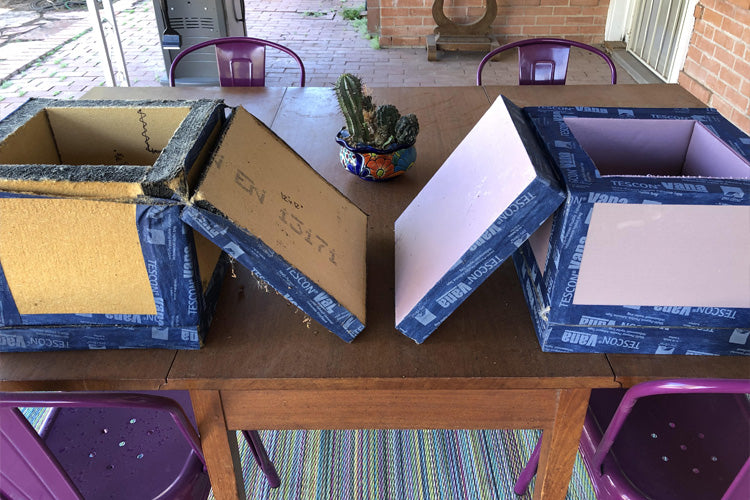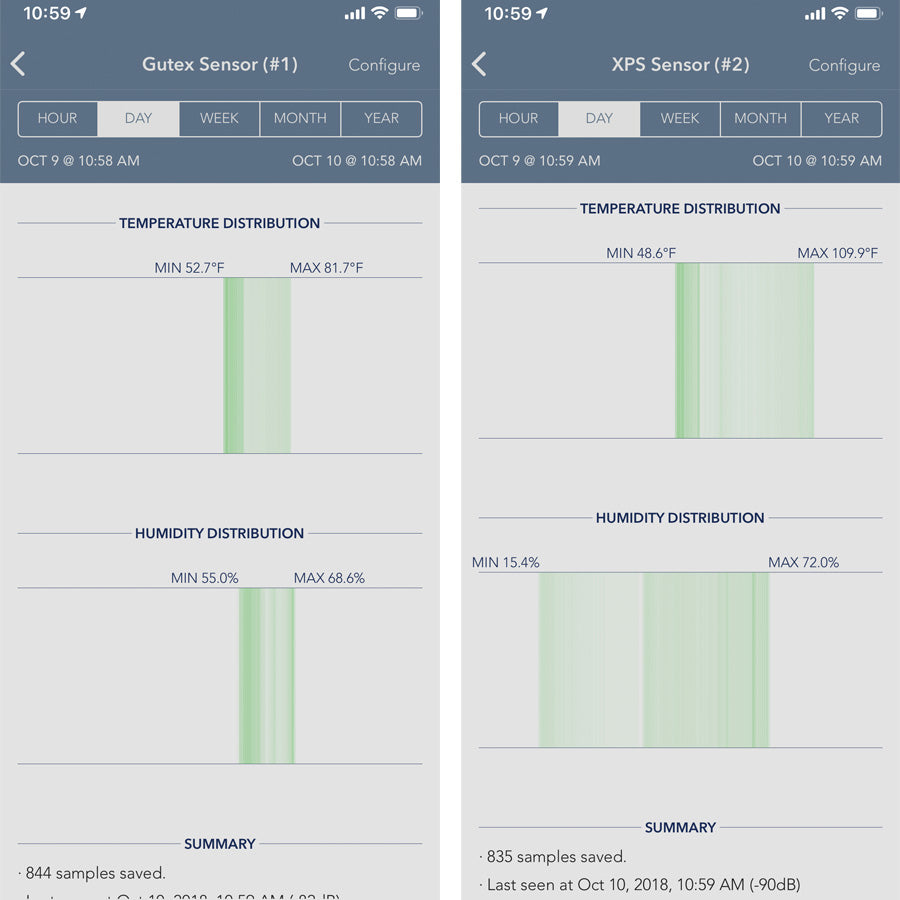High-Performance Gutex Wood Fiber Insulating Materials Outperform Foam
Due to the density and specific heat capacity of wood, Gutex wood fiber insulation is able to far outperform unsustainable and unhealthy materials such as XPS foam insulation. While Gutex has a lower R-value per inch (R-3.7) than XPS (R-5), it is important to note that R-value is an inaccurate and incomplete way to predict real-world performance. To illustrate this point, with real-world conditions, we built two boxes: one Gutex box rated at R-5.7 and one XPS box rated at R-10. Over a month of data collection using SensorPush digital temperature and humidity loggers, the results deepen our understanding of Gutex’s superior performance despite having a roughly 40% lower installed R-value.
Analyze This
It has become critically apparent that we need to make buildings more energy efficient, and we know the materials selected to achieve this goal can have a huge impact on success or failure, even if we don’t always fully appreciate it. Natural insulation materials have many benefits such as better health, higher durability, and lower embodied carbon (Magwood 2017). However, what is often not discussed, or appreciated, is that natural insulation materials, like wood fiber, can deliver much better performance ranging from soundproofing to thermal performance (Gutex 2018).
Standard tests for R-value use a steady-state temperature (ASTM 2018), but our enclosures exist in a world of highly variable temperatures. Furthermore, R-value tests typically only include conductive heat transfer, missing any influence of radiant heat transfer, and are conducted under unrealistic conditions, such as 50 degrees F at the interior with 100 degrees F at the exterior (Bailes 2013).
Another metric for understanding the real world? The best metric available is probably Thermal Diffusivity, which includes the heat transfer coefficient, but also includes the density and specific heat capacity of the material. The specific heat capacity is how much heat is required to change the temperature of a material. Foam does not require much heat to change temperature, but wood requires a lot more heat to change temperature. Density matters because it determines how much material exists per unit thickness. Consequently, wood fiber insulation can actually provide greater comfort and efficiency despite having a lower listed R-value than foam.
But, of course, the best we can do is collect empirical data and analyze it, and so that’s what we did.
Experiment Details
The experiment was conducted in Tucson, Arizona during September-October 2018. Two nearly identical boxes were constructed and placed in the exact same ambient conditions for a month of data collection. The only difference between the boxes was that the XPS box was thicker to deliver a much higher R-value. Each box is exactly 1 cubic foot. The Gutex box is 1 9/16” thick Thermosafe WD to achieve R-5.7 and the XPS box is 2” thick to achieve R-10. The boxes were air sealed used the exact same method (Pro Clima Tescon Vana tape and Pro Clima Multibond). A SensorPush digital temperature and humidity data logger was placed in the exact same center-of-box location in the Gutex box and the XPS box.
The boxes were placed so that there would be no shading between the boxes and so that the boxes would receive the exact same amount of solar radiation, ambient heat, rainfall, and other ambient conditions. After two weeks the boxes were moved to a new location to ensure data was consistent with the first location to help verify readings.
Results

Results showing higher variability and more extreme temperatures in XPS box (red line) than the Gutex box (blue line)
As can be seen in the above images, the temperature and humidity in the XPS box was both more extreme and more variable than the Gutex box, despite the Gutex box having a roughly 40% lower R-value. This supports the proposition that R-value is an incomplete metric in determining real-world comfort and efficiency delivered by insulation.
Comfort & Climate
Research has also shown that comfort is the biggest motivator for people to engage in high-performance new construction as well as retrofits (Bean 2018). Comfort coupled with the benefits of efficiency and carbon sequestration make Gutex wood fiberboard an obvious choice when working to mitigate the climate crisis through the built environment.
References
- Chris Magwood, 2017
- New Carbon Architecture
- Gutex Website, 2018
- https://gutex.de/en/product-range/product-properties/insulation-in- summer/
- Allison Bailes, April 24, 2013
- https://www.energyvanguard.com/blog/59419/Big-News-The-R-Value-of- Insulation-Is-Not-a-Constant
- ASTM Website, 2018
- The three most frequently used test methods to measure R-value are:
- ASTM C 177, Standard Test Method for Steady-State Heat Flux Measurements and Thermal Transmission Properties by Means of the Guarded-Hot-Plate Apparatus.
- ASTM C 518, Standard Test Method for Steady-State Heat Flux Measurements and Thermal Transmission Properties by Means of the Heat Flow Meter Apparatus.
- ASTM C 976, Standard Test Method for Thermal Performance of Building Assemblies by Means of a Calibrated Hot Box.
- Robert Bean, Seattle, WA October 4, 2018
- Presentation at Sustainable Walls Symposium, ASHRAE 55.5



 Figure 1. Construction of the Gutex and XPS boxes
Figure 1. Construction of the Gutex and XPS boxes
 Figure 2. Location of boxes during experiment
Figure 2. Location of boxes during experiment
 Figure 3. SensorPush Datalogger
Figure 3. SensorPush Datalogger
 Figure 4. Second location of boxes, moved after 2 weeks to ensure consistent data.
Figure 4. Second location of boxes, moved after 2 weeks to ensure consistent data.
 Results showing higher variability and more extreme temperatures and humidity in the XPS box
Results showing higher variability and more extreme temperatures and humidity in the XPS box
 Results with ambient weather
Results with ambient weather
 Demonstrating specific heat capacity
Demonstrating specific heat capacity
